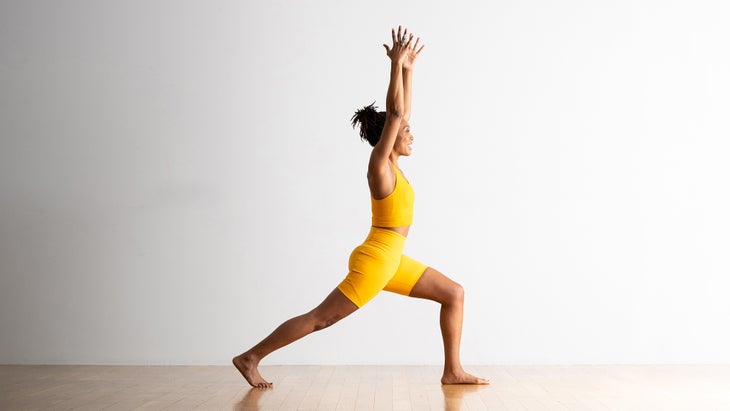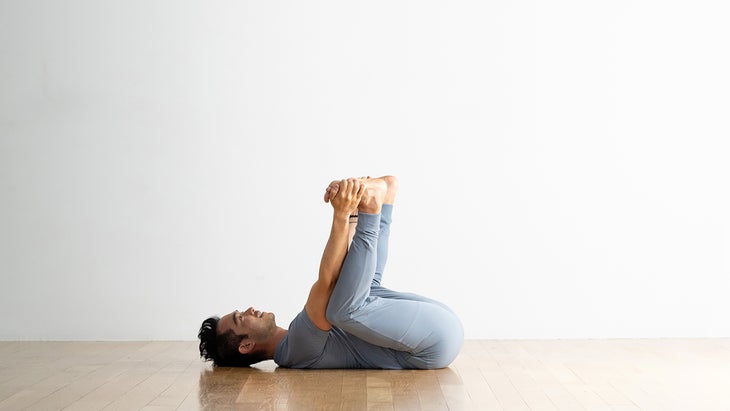“], “filter”: { “nextExceptions”: “img, blockquote, div”, “nextContainsExceptions”: “img, blockquote, a.btn, a.o-button”} }”>
Time, as we know from the work of Albert Einstein, is relative. Take 30 minutes. It can seem to last interminably while you’re sitting in a meeting or doctor’s waiting room yet it can slip past almost unnoticed when you’re experiencing something that inspires you to lose yourself—and, at the same time, find yourself—in the moment, whether it’s reading or hanging with friends or coming to a 30-minute yoga practice.
What’s more objective about that half hour are the benefits of devoting them to yourself each day. Studies overwhelmingly indicate profound health benefits of taking 30 of your 1440 minutes each day to somehow move your body at a moderate intensity for cardiovascular health, blood pressure, reduced risk of stroke and cancer, stronger immunity, even stress reduction and enhanced creativity.
When you consider the well-documented strengthening and stretching and soothing effects of yoga, it becomes less of a question “if” you’ll practice and more of a matter of “when.” You can turn to the following 30-minute yoga sequence any time you can eke out some time for yourself, although many of us are more likely to have the time first thing in the morning.
And those days when it’s simply impossible to find half an hour, you can still derive those same or even greater benefits from coming to your practice in more manageable chunks of 20 or even 10 minutes with shorter versions of this practice.
A 30-minute yoga practice to jump-start your day
Cat-Cow Pose
Come onto your hands and knees and stack your shoulders over your wrists and your hips over your knees. As you exhale, press down through your palms, round your back, and tuck your chin in Cat.

As you inhale, slowly arch your back and lift your chest into Cow. Begin to move your spine in a rhythmic motion, moving with your breath for as long as you need.

Tabletop
From all fours, lift your belly in toward your spine in Tabletop. Either stretch your forearms by angling your fingers away from the center of the mat or turning them toward your knees or take a backbend by extending your right leg straight behind you, bending your right leg, and reaching behind with your left hand to grab your foot. If backbending, press your foot away from you as you lift your chest and come into a slight backbend. Breathe here. Slowly lower to the mat and repeat on the other side.

Adho-Mukha Svanasana (Downward-Facing Dog Pose)
From Tabletop, inhale as you tuck your toes under and lift your hips up and back. Pause here and breathe. Downward-Facing Dog Pose, inhale as you lift your right leg up high behind you, and then exhale as you round your spine as you draw knee to chest. Keep your pelvis low and round your upper spine toward the sky. Hug your right thigh to your chest and knee to your nose. Keep pressing the floor with your hands. Return to Downward Dog and repeat with the left leg.

Vasisthasana (Side Plank Pose)
From Down Dog, shift your weight slightly forward so your shoulders are almost stacked above your wrists. Roll your heels to the right. Shift your weight into your right hand and the outer edge of your right foot. Turn your gaze down as you stack your left foot on top of your right (or you can keep the inner edge of your left foot on the mat) in Side Plank Pose. Fire up your thigh muscles and press your feet and right hand down as you lift your hips. Bring your right hand to your hip or extend it toward the ceiling. If you feel steady, slowly turn your gaze up to the ceiling. Breathe. Either return to Downward-Facing Dog or proceed to Wild Thing.

Wild Thing
From Side Plank, slowly step your right foot behind you. Keep your left foot grounded onto the mat and your left leg straight. Lift your hips and chest toward the ceiling and reach your right arm alongside your ear. Press down through every part of you that touches the mat to lift the rest of your body into a slight backbend. Let your head gently hang back. Breathe. Return to Downward Dog. If you need, take Child’s Pose for several breaths before returning to Down Dog. Repeat Side Plank and Wild Thing on the other side.

Plank Pose
From Downward Dog, shift your shoulders forward over your wrists. Keep your legs and core engaged and press your hands and feet into the mat. Press your heels toward the wall behind and reach through the top of your head toward the wall in front of you in Plank Pose. Breathe.
Instructions: Practice 5 rounds of the following poses, holding each for 3-5 breaths or 15 seconds. If the pose moves from left to the right side, practice for 15 seconds on each side. If you don’t have time for a full 30-minute yoga practice, skip the repetitions and proceed.

Chaturanga Dandasana (Four-Limbed Staff Pose)
From Plank, bend your elbows and slowly lower halfway to the mat, keeping your elbows drawing in toward your sides in Chaturanga Dandasana. Press your hands into the floor, push back through your heels, and engage your core. You can modify the pose by lowering your knees to the mat.

Urdhva Mukha Svanasana (Upward-Facing Dog)
From Chaturanga, press your hands and the tops of your feet down, to bring your thigh bones off the floor as you lift your torso in Upward-Facing Dog Pose. Draw your upper arm bones toward your back to open your heart. Keep your neck long as you gaze up.

Downward-Facing Dog Pose
From Up Dog, roll over the tops of your feet, press into your hands, and lift your hips up and back into Down Dog. Spread your fingers wide, lift your sitting bones toward the ceiling, and draw your belly and low ribs toward your spine.

High Lunge
From Down Dog, step your left foot between your hands. Press through your lifted back heel and release your pelvis toward the mat to stretch your back hip flexor. Lift the sides of your waist out of your hips. Bring your arms alongside your ears and gaze straight ahead in High Lunge. Breathe.
If you’d like to twist in High Lunge, bring your hands to prayer at your chest and twist your chest to the left. Press your right upper arm into the outside of your outer left thigh. Press your palms together and draw your shoulder blades away from your ears. Turn your gaze upward or keep looking straight ahead.
From High Lunge or High Lunge with a twist, exhale and bring your hands back to the mat. Step back to Plank and make your way to Down Dog, either by drawing your hips up and back or going through Chaturanga and Up Dog. Repeat on the other side.
Repeat the poses after Wild Thing for up to 5 rounds.

Setu Bandha Sarvangasana (Bridge Pose)
From Downward Dog, walk or jump forward and bring your seat to the mat before you recline on your back. Bend your knees and bring your feet to the mat with your ankles directly under your knees and bring your arms alongside your body, palms down. Press the edges of each foot down, inhale, and lift your hips as high as you can in Bridge Pose. Press your upper arms into the mat or interlace your fingers, shimmy your upper arms beneath your back, and press your pinky fingers into the mat. Lift your chest and reach your tailbone toward the backs of your knees. Breathe. Repeat twice.

Urdhva Dhanurasana (Wheel or Upward Bow Pose)
From Bridge Pose, Bring your hands alongside your ears, palms down, fingers facing your feet. Press your hands and feet down as you inhale and lift your hips and torso into Urdhva Dhanurasana. Straighten your arms and relax your head down. Breathe into your upper chest. If you’re not comfortable practicing Upward Bow, practice Bridge or remain on your back. Breathe.

Supta Baddha Konasana (Reclining Bound Angle Pose)
From lying on your back, bring the bottoms of your feet together, allowing your thighs to release toward the floor in Reclining Bound Angle Pose. Place your left hand on your heart and your right hand on your low belly. Close your eyes and let your belly expand as you inhale; sink as you exhale. Breathe.

Ananda Balasana (Happy Baby Pose)
From lying on your back, reach for the outer edges of your feet or your calves and gently draw your knees toward your armpits, trying to keep your ankles stacked over your knees in Happy Baby Pose. You can instead place your hands on your calves. Release your sacrum onto the floor and rock gently from side to side, playing and experiencing an inner lightness. Breathe.

Savasana
Release your feet and extend your legs on the floor, letting them relax. Release your arms by your sides, allowing them to rest on the floor, palms up. Let yourself expand and take up a lot of space in this final resting pose, Savasana. Release all your muscles and let the power of your practice sink into your body. Breathe freely.
This completes your 30-minute yoga practice. As you come back to it, you can adapt it as you like, adding or taking away poses to suit your preferences and needs.
This article has been updated. Originally published January 7, 2015.

